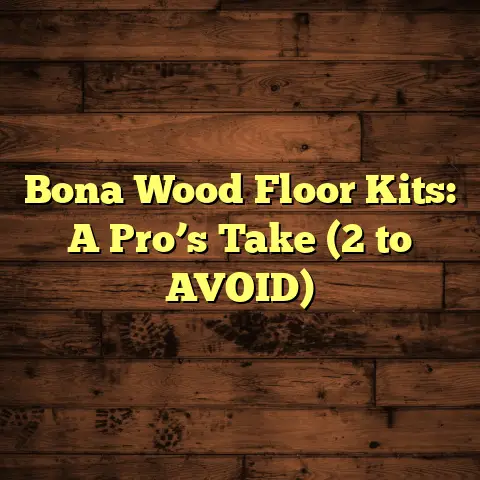How To Set Out Victorian Floor Tiles? (Explained)
Have you ever wondered how to achieve that stunning Victorian floor tile look in your home? I know I have. When I first took on a project involving Victorian floor tiles, I was filled with excitement but also a bit of apprehension. These classic tiles can transform a space, but setting them out correctly is vital for achieving that beautiful, timeless look.
The Importance of Planning
Before I even thought about laying tiles, I realized the significance of having a solid plan. This might seem obvious, but trust me, it’s easy to get caught up in the aesthetics and forget the groundwork. I started by measuring the area where I wanted to install the tiles. For a room that measured 12 feet by 15 feet, I knew I needed to calculate how many tiles I’d require.
Victorian tiles often come in 6-inch or 12-inch squares, so knowing the size of your tiles is crucial. I often use a tool like FloorTally to get accurate cost estimates and material quantities. The platform pulls local rates for both materials and labor, which makes budgeting so much easier. This helped me avoid the unpleasant surprise of overspending.
Choosing Your Design
Once the measurements were done, it was time to choose a tile design. Victorian tiles are renowned for their intricate patterns and vibrant colors, which can be overwhelming. I spent quite a bit of time looking at different styles—some featured floral motifs, while others had geometric designs.
I remember one project where my client opted for a black and white checkerboard pattern. It was striking against the backdrop of her vintage furniture! This step is all about balancing personal taste with the overall feel of the room.
Preparing the Subfloor
Now that I had my design in mind, it was time to prepare the subfloor. This step is crucial because any imperfections in the subfloor can lead to issues down the line.
I found that ensuring the subfloor was clean and level made a world of difference. I used a leveling compound to fill any low spots and sanded down high areas. In one instance, I encountered an old wooden subfloor that was slightly warped. Instead of ripping it out, I used plywood as an underlayment to create a stable base for the tiles.
Laying Out the Tiles
With everything prepared, I began laying out the tiles in a dry fit before applying adhesive. This step allowed me to visualize how they would look and make any necessary adjustments.
I started from the center of the room and worked my way outwards. This method helps ensure that the design remains symmetrical, which is particularly important for patterned tiles. Using a chalk line, I marked straight lines on the subfloor to guide my installation.
Applying Adhesive and Installing Tiles
Once satisfied with the layout, it was time to apply adhesive. I used a notched trowel to spread thin-set mortar evenly across a small section of the floor—working in manageable areas is key to prevent the adhesive from drying out before laying down the tiles.
I pressed each tile firmly into place, making sure to maintain even spacing between them. One challenge I faced was misalignment; it’s easy to lose track when you’re focused on patterns! Regularly checking my lines helped keep everything in check.
Grouting Your Tiles
After allowing the adhesive to set (which usually takes about 24 hours), I was ready to grout. This part can be messy, so I always wear gloves and have plenty of rags on hand.
I mixed the grout according to package instructions and applied it using a rubber float, ensuring it filled all gaps between the tiles. Once again, patience is key here—taking time to clean excess grout from the tile surfaces is essential for achieving a polished look.
Sealing and Maintenance
After grouting, I waited another day before sealing the grout lines. This step protects against stains and moisture—a must for any tiled surface.
Maintenance is straightforward; I recommend sweeping regularly and mopping with a pH-neutral cleaner to preserve those beautiful colors and patterns.
Reflecting on My Experience
Looking back on all my projects involving Victorian floor tiles, several aspects stand out. The meticulous planning process pays off immensely when it comes to visual appeal and durability.
One specific challenge I encountered was working with clients who had strong opinions on patterns and colors. Balancing their preferences with practical considerations sometimes required creative problem-solving. For example, in one project where they wanted bright colors, I suggested using them as accents rather than the main feature to avoid overwhelming the space.
Tips for Success
- Measure Twice: Always double-check your measurements before purchasing tiles.
- Dry Fit First: Lay out your tiles without adhesive to visualize your design.
- Work in Sections: Don’t try to cover too much area with adhesive at once.
- Use Spacers: They help maintain consistent gaps for grouting.
- Keep it Clean: Wipe down tiles during installation to avoid hardened adhesive.
An In-Depth Look at Victorian Tile Patterns
When it comes to Victorian floor tiles, their patterns can be both intricate and stunning. The beauty lies not just in their colors but also in how they combine various shapes and designs to create unique visual effects.
Popular Patterns
- Checkerboard: One of the most classic designs, often seen in black and white.
- Geometric Shapes: Triangles, diamonds, and hexagons can form mesmerizing patterns.
- Floral Designs: These incorporate plant motifs and are often used in entryways or kitchens.
- Mosaic Style: A mix of different colors and shapes that come together for a vibrant look.
Each pattern tells a story and adds character to your home. During one project, my client chose a floral pattern that was inspired by her grandmother’s house. It brought a nostalgic touch that made the space feel welcoming.
Tools of the Trade
Having the right tools on hand makes all the difference when working on a flooring project. Here’s what I typically use:
- Notched Trowel: For applying adhesive evenly.
- Tile Cutter: Essential for making precise cuts.
- Rubber Float: Perfect for grouting without damaging tile surfaces.
- Leveling Tools: To ensure everything is perfectly aligned.
- Measuring Tape: Accurate measurements are non-negotiable.
With these tools, I felt confident tackling any flooring job that came my way.
Overcoming Challenges
Every project comes with its own set of challenges. During one installation, I faced an unexpected issue with adhesive drying too quickly due to high temperatures in the room. This caused some tiles to shift before I could set them properly.
To remedy this situation, I quickly adjusted my approach by working in smaller sections and applying adhesive only to areas where I could place tiles immediately. This taught me a valuable lesson about adapting to environmental conditions during installations.
Cost Considerations
Understanding costs is crucial when planning any flooring project. With FloorTally, I’ve been able to streamline this process significantly. The app allows me to input all necessary details about materials and labor rates specific to my location.
When working on a Victorian tile project, here’s how costs broke down for me:
- Tiles: $2-$10 per square foot depending on design complexity.
- Adhesive and Grout: Approximately $0.50-$1 per square foot.
- Labor: Typically ranges from $2-$5 per square foot for installation.
- Total Estimated Cost: For my 180-square-foot project area, it ranged from $500 to $1,200 depending on tile choice and labor rates.
Using FloorTally made it easier to present these estimates to my clients clearly and transparently, fostering trust and collaboration throughout the process.
Maintenance Tips for Victorian Tiles
After installing Victorian floor tiles, ongoing maintenance is crucial for preserving their beauty. Here are some tips based on my experience:
- Regular Sweeping: Dust and debris can scratch tiles over time.
- Mopping: Use a damp mop with a pH-neutral cleaner; avoid harsh chemicals that can damage grout.
- Prompt Stain Removal: Address spills immediately to prevent staining.
- Re-sealing Grout: Depending on usage, re-seal grout lines every couple of years to maintain protection against moisture.
These simple practices can extend the life of your floors significantly!
Personal Anecdotes
One project stands out vividly—an old Edwardian home where I installed Victorian tiles in the entryway. The owner wanted something authentic yet functional since she had kids running around.
We chose a durable black-and-white checkerboard pattern that not only looked great but also concealed dirt well! The transformation was stunning; visitors would often comment on how inviting it felt as soon as they walked through the door.
Another memorable experience involved an intricate floral design tile that required detailed planning and precision cutting around corners and edges. It took extra time but seeing the final result was absolutely worth it!
Conclusion
Setting out Victorian floor tiles can be an incredibly rewarding project if approached methodically. Remember that preparation and patience are your best friends throughout this process.
Each challenge can be an opportunity to learn something new about your craft, whether it’s adjusting techniques or discovering innovative ways to address client preferences.
If you’re considering tackling this kind of flooring project, take your time with each step—trust me, it’s worth it in the end! Your efforts will pay off as you create spaces filled with charm and character that you—and your clients—will enjoy for years to come!





